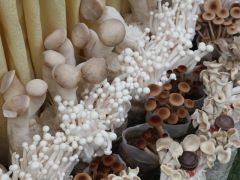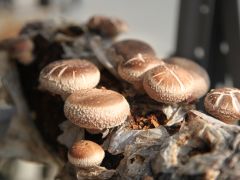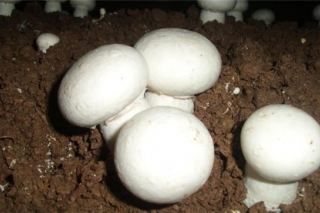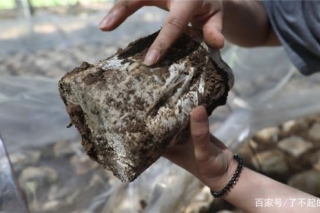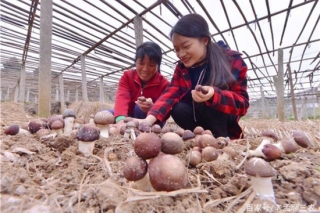Improvement of Spawn, Compost and Cultivation Technique for Oyster Mushroom
Abstract:A series of works related with growing techniques for oyster mushroom were implemented to improve the efficiencies involved in spawn, compost, cultivation. To enhance the quality of sawdust spawn,fermentation technique was introduced to the spawn making. In an attempt to solve the problems of growing basic factor, the improvement of preparation of the substrate was carried out. Quality and productivity of Pleurotus ostreatus and P. sajor-caju were also assessed by a perforated polythene sheet covering technique.A method of spawn making procedures through the application of fermented sawdust for the purpose of avoiding contamination by undesirable fungi in the course of Pleurotus ostreatus mycelial growth was evaluated. Of three kinds of supplements, rice bran was the most effective to raise temperature up to 70?B℃. Mycelial activity and density were more considerably improved in the case of using fermented sawdust supplemented with rice bran than the case of non-fermented sawdust. Primordia of Pleurotus ostreatus were formed on fermented sawdust. The substrate of fermented sawdust showed potential to prevent the growth of Trichoderma sp. which caused a symptom on mushroom mycelium, whereas there was nothing to inhibit the growth of Trichoderma sp. during 30 days after inoculation in non-fermented sawdust. A composting technique was assessed to enhance efficiency in oyster mushroom substrate. Poplar sawdusts and by-product of winter mushroom added by 10% rice bran were composted outdoors at 20?B℃ to 28?B℃ for 12 days. The duration of composting shortened 3 days in fermented sawdust plot. The oyster mushroom substrate with fermented sawdusts promoted initial pins to produce a large lump of primordia. The highest yield was 742 g obtained from waste cotton substrate with fermented poplar sawdust, whereas the yield in control treatment 663 g. In addition, the substrate with by-product of winter mushroom was the most effective to composting. It was useful to apply fermented sawdust and recycled by-product to waste cotton associated with compost and sporophore production.Pleurotus spp. cultivation has been beset by several problems:contamination by undesirable microorganisms and pests, intensive labor requirements, and low crop quality owing to poor bed management. In an attempt to solve these problems, a perforated polythene sheet covering technique was assessed on crops of Pleurotus ostreatus and Pleurotus sajor-caju.At spawning, beds were covered with perforated transparent and black plastic sheet (0.03 mm thick; 10 cm diameter holes were spaced 10 cm apart giving 25 holes/m2). Additional spawn was inoculated to the bed surface through the holes. This technique made picking quicker with more efficient use of labor as mushrooms formed in bunches. Total yield of P. ostreatus increased by 5.7% to 10.8 kg/m2. The mean weight of a mushroom bunch from polythene sheet covered beds was 283 g (33 fruitingbodies) compared to 117 g (15 fruitingbodies) obtained using conventional growing methods. P. sajor-caju rapidly colonized the substrate and individual fruitingbodies formed into discrete bunches at the site of each hole. Total yield of mushrooms from both P. sajor-caju cultivation systems was 8 kg/m2. The mean of weight of mushroom bunches from a covered bed was 225 g (79 fruitingbodies) compared to single fruitingbodies (2.5 g) picked when using the conventional growing method. The evenness of the flush made picking quicker and reduced labor input by 52% (P. ostreatus ) and 64% (P. sajor-caju). Mycelia of ??Pleurotus spp. under vinyl remained healthy and white;whereas mycelium grown using conventional methods changed from white to yellow-brown during the cropping cycle. Very few fruitingbodies aborted after initiation using the covering technique.It is recommended that cultivation technique should be established on oyster mushroom based on improvement of spawn and compost.
Keywords:oyster mushroom; spawn; compost; cultivation technique
提高平菇产量的栽培新技术
Oh Se Jong Park Jeong Sik Shin Pyung Gyun Yoo Young Bok
摘 要:探讨了一系列有关菇床的制备、栽培料的处理和发酵等提高平菇产量的栽培措施.为了提高锯木屑的利用率,在制备菇床时引进了发酵技术;为了解决生长中一些基础问题,改进了培养基质的处理方法.同时也评估了聚乙烯薄膜钻孔覆盖技术对两种平菇(Pleurotus ostreatus和 P. sajor-caju)产量和品质的影响.在平菇菇床制备的过程中,为避免其它真菌菌丝的污染,使用了发酵后的锯木屑法.结果表明,所用的3种添加物中,稻糠是促使培养基质升温效率最高的添加物,可以升高到70?B℃.应用发酵锯木屑添加稻糠生产的菌丝的活力和密度大大高于非发酵锯木屑培养,并且其上可见平菇原基的形成.发酵锯木屑在预防木霉的污染上显示了一定的潜能,而非发酵锯屑在接种后30 d内对木霉无能为力.研究了堆料(发酵)对平菇培养基物效率的提高能力.在白杨树锯木屑和冬蘑菇的栽培废料中加入10%的米糠后,在20~28?B℃下室外堆放12 d.在发酵锯木屑钵中发酵的持续时间缩短3 d.平菇在发酵基质中生长可以加快子实体原基的形成.用棉籽壳和发酵的白杨锯木屑混合可以获得最高的产量(742 g),而对照只有663 g.另外,用白杨锯木屑与冬蘑菇培养废料混合可以最有效提高发酵效率.在棉籽壳中添加发酵的锯木屑和可循环的农副产品可以促进培养基质发酵和子实体形成.许多问题困扰着平菇的栽培:微生物和害虫的污染,高强度的劳动力,因菇床管理不善而造成的栽培质量问题等.为了解决这些问题,凿孔聚乙烯薄膜覆盖技术被用来栽培Pleurotus ostreatus 和Pleurotus sajor-caju.菇床覆以打孔的、透明的、黑色的塑料膜(0.03 mm厚,孔直径10 cm,孔间距10 cm以保证25 孔/ m2).菌种自孔接入菇床表面.此项技术因蘑菇成束形成而使采摘时效率更高,P. ostreatus的产量每平方米增加5.7% 到10.8 kg.聚乙烯薄膜覆盖的菇床每束蘑菇的平均重量283 g(33子实体),而传统的栽培方法为117g(15子实体).P. sajor-caju可以快速在基质上生长和定殖,并在孔口周围成束长出子实体.P. sajor-caju栽培系统的总产量为8 kg/m2,薄膜覆盖栽培平均每束菇的重量为225 g(79个子实体,而传统的方法栽培的平均子实体重量为2.5 g.由于菇床平坦,有利于快速采摘,降低劳动力达52%(P. ostreatus)或64%(P. sajor-caju).在薄膜下面,平菇的菌丝保持健白色,健康状态,而传统的栽培经过一轮的采摘后,菌丝变黄.用薄膜覆盖技术很少出现菇体不能发育成熟的现象.因此这种建立在提高栽培料组合和发酵基础上的平菇栽培新方法值得推荐.
关键词:平菇; 栽培; 菇床; 栽培料
CLC Number:S646.1+4
Foundation Item:Supported by Rural Development of Administration (RDA)
Author Resume:Oh Se Jong,male,born in 1961,researcher.Address: Div. of Applied Microbiology, National Institute of Agricultural Science and Technology, RDA 441-707 Suwon Korea.E-mail : sejongoh@rda.go.kr
Author Unit:Oh Se Jong(National Institute of Agricultural Science and Technology,RDA,441-707,Suwon Korea)
Park Jeong Sik(National Institute of Agricultural Science and Technology,RDA,441-707,Suwon Korea)
Shin Pyung Gyun(National Institute of Agricultural Science and Technology,RDA,441-707,Suwon Korea)
Yoo Young Bok(National Institute of Agricultural Science and Technology,RDA,441-707,Suwon Korea)
References:
[1]Ivanovich-Biserka B. Dealing with microbiological trouble-makers in commercial spawn production of Agaricus bisporus.Mushroom Science,1972,8: 305~314
[2]Fritsche G. Some remarks on the breeding, maintenance of strains and spawn of Agaricus bisporus and A. bitorquis. Mushroom Science,1981,11: 367~385
[3]Lemke G. Praktische Erfahrungen bei der Brutherstellung. Der Champignon,1972,126: 2~23
[4]Stoller B B. Some practical aspects of making mushroom spawn. Mushroom Science,1962, 5: 170~184
[5]Chang S T, Hays W A. The biology and cultivation of edible mushrooms. London and N Y:Academic press,1978. 219~237
[6]Paul P, John D. Shiitake growers handbook. Kendall/Hunt publishing company,1990
[7]Block S S, Tsao G ,Han C . Experiments in the cultivation of Pleurotus ostreatus.Mushroom Science,1959, 4: 309~329
[8]Chang S T,Miles P G,eds.Edible mushrooms and their cultivation. Boca Raton, Florida:CRC Press,1987.18~25
[9]Carapiet G. Phase Ⅱor cookout. Mushroom Sci, 1981,11(part 1): 311~318
[10]Gerrits J P G. Factors in bulk pasteurization and spawn-running. Mushroom Sci,1981,11(part 1): 351~365
[11]Wang H C ,Shou C H The Development of phase Ⅱcomposting for mushroom cultivation in China. Mushroom Sci,1981, 11(part 1): 319~326
[12]Oh S J, Shin P G, Weon H Y, et al.Effect of fermented sawdust on Pleurotus spawn. Mycobiology,2003,31(1): 46~49
[13]Omori S. Some discussions about the cultivation of Pleurotus ostreatus on sawdust bed. Mushroom Science,1974,: 663~665
[15]Park Y H, Go S J, Chang H C. Studies on the cultivation of Oyster Mushroom, Pleurotus ostreatus (Fr.) Quel. Using rice straw as growing substrate Ⅱ. The effect of heat treatment to the substrate. Report O R D. 1977,19(S.F.P. &M): 93~97
[16]Park Y H, Go S J,Kim D S.Studies on the cultivation of Oyster Mushroom, Pleurotus ostreatus (Fr.) Quel. Using rice straw as growing substrate Ⅰ. Experiment on the development of growing substrates. Report O R D,1975,17(S.F.P. &M): 103~107
[17]Tan K K. Cotton waste is a good substrate for cultivation of Pleurotus ostreatus, the Oyster Mushroom. Mushroom Science. 1981,11: 667~673
[18]Harman G E,Kubicek C P. Trichoderma & Gliocladium. Volume 2. London:Taylor & Francis Ltd,1998
[19]Kneebone L R, Merek E L. Brief outline of and controls for mushroom pathogens, weed mould and competitors. Mushroom Growers Assoc Bull,1959,113: 146~153
[20]Smith J F, Hayes W A. Use of autoclaved substrates in nutritional investigations on the cultivated mushroom. Mushroom Sci, 1972, 8: 355~361
[21]Kurtzman R H,Zadrazil F.Physiological and taxonomic considerations for cultivation of Pleurotus mushrooms, in tropical mushrooms. Hong Kong:The Chinese University Press,1982. 299
[14]Jandaik C L,Kapoor J N,Studies on Cultivation of Plurolus sajor-caju Mushroom Sciexce IX(Part I),1974,:667~672
华中农业大学学报
JOURNAL OF HUAZHONG AGRICULTURAL UNIVERSITY
2004 Vol.23 No.1






